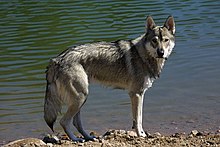Breeding back




Breeding back can be described as either a natural or a human attempt to assemble or re-assemble the genes of an extinct species, subspecies or of a domesticated breed, which may still be present in the larger gene pool of the overall species or other interbreedable species.
Breeding back is controversial, especially claims that an extinct animal has been recreated. Similar appearance (phenotypical reconstruction) does not assure similar behavior. For some of the species that are being bred back, questions remain about the ecological niche, hardiness, and disease resistance of the original species. For instance, the aurochs died out almost 400 years ago and the records kept cannot definitively answer some of these questions.
Domestic examples
In domestic animals, there are now several examples of breeding back.
Dogs
The American Alsatian dog breed has been created to resemble the bone and body structure of the Dire Wolf, although not the temperament.[1] Other dog breeds that attempt to recreate a 'wolf-look', without actually cross breeding with wolves, are the Tamaskan Dog, Utonagan, and the Northern Inuit dog breeds.
Some speculate that it may be possible to breed back the now extinct Japanese Wolf, since Asian wolves possibly crossed with Japanese wolfdogs.
Grazing animals
Other selectively bred examples of breeding back include that of the aurochs, the extinct forerunner of domestic cattle. The products of these attempts are called the Heck cattle. The Heck horse, a phenotypic copy of the tarpan has also been produced, although it lacks the upright manes.
Another prominent breeding back effort is the Quagga Project to bring back the extinct subspecies of the Plains Zebra called Quagga.
Back breeding in the wild
Back breeding is also sometimes alleged to occur in feral animal populations. It is not certain if "primitive" feral breeds (such as of sheep or pigs) are so only because their ancestors were of primitive domestic breeds or if they have had a kind of natural back breeding.
It is widely accepted that pigs will readily "go feral" and in the case of the introduced Razorbacks to the USA, pigs seem to revert to a 'wild boar' like state in not only appearance but also behavior and hardiness. Some individuals identified as European wildcats are suspected to be descended feral domestic cats.
See also
References
- ^ "Standards of the Breed". National American Alsatian Club. 2009. Retrieved 2010-11-05.
{{cite web}}: Unknown parameter|month=ignored (help)
- Koene, P., & Gremmen, B. (2001). Genetics of dedomestication in large herbivores. In 35th ISAE Conference, Davis, California, 2001 (pp. 68-68).
